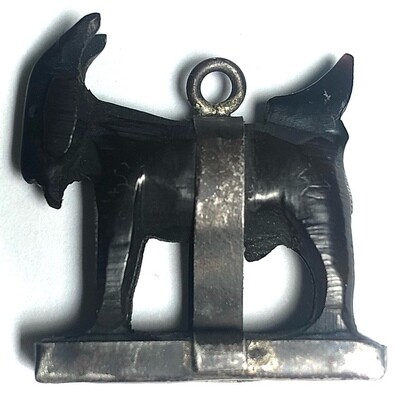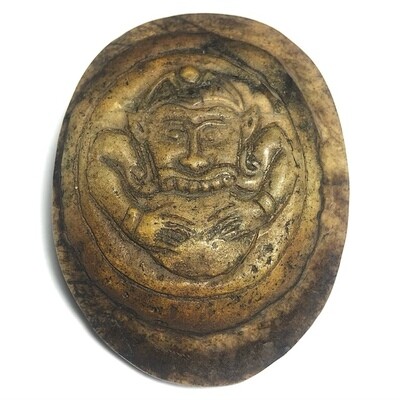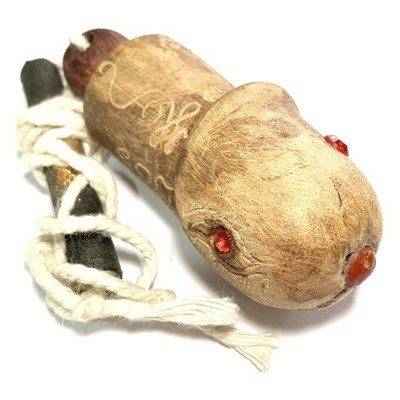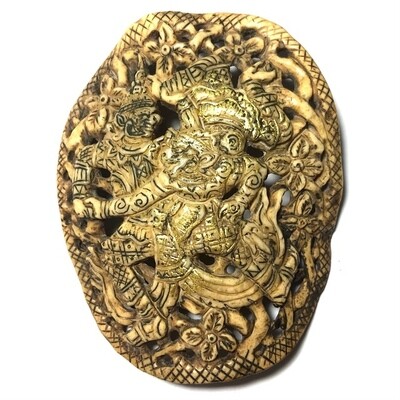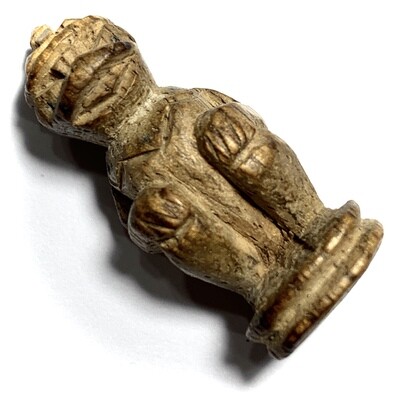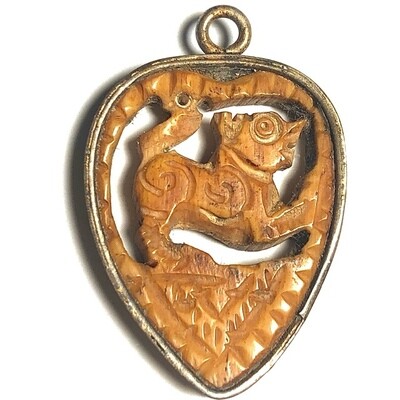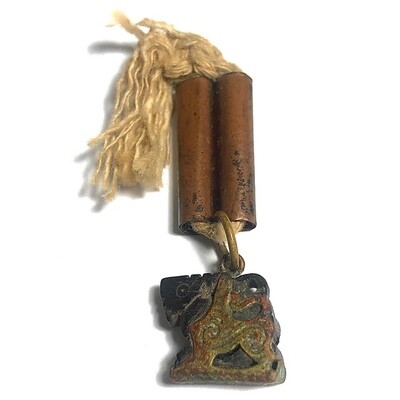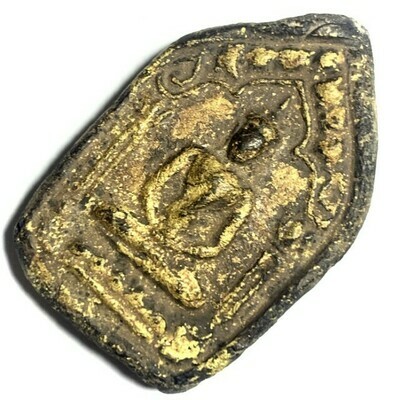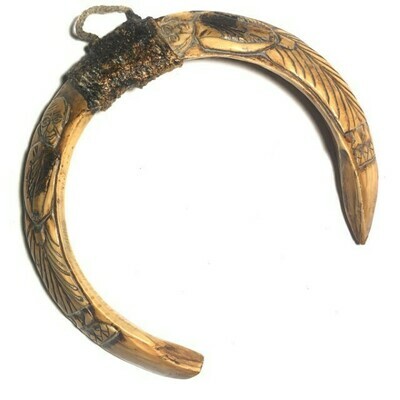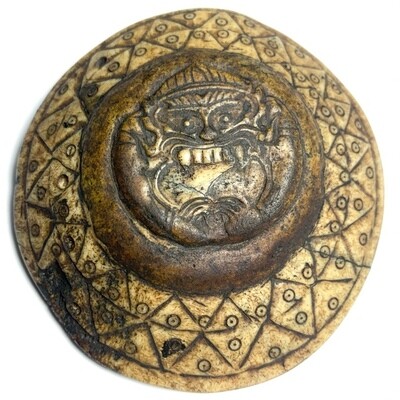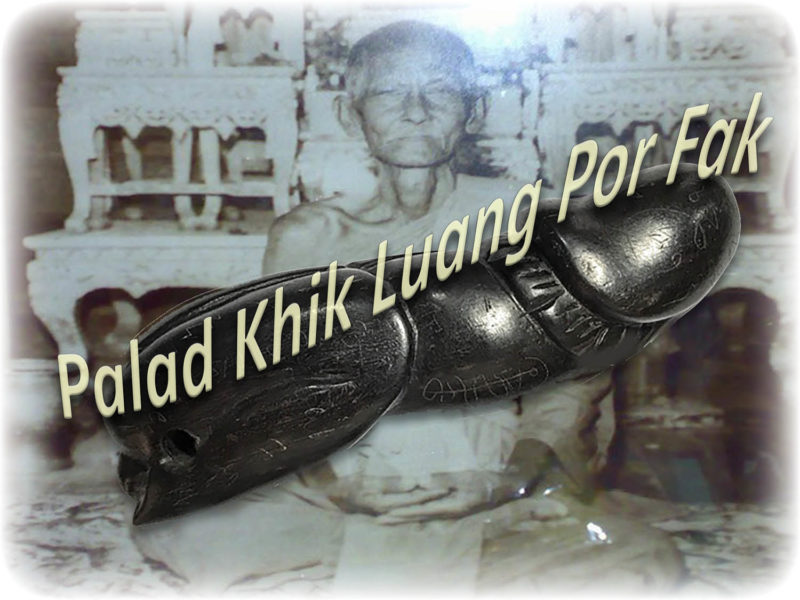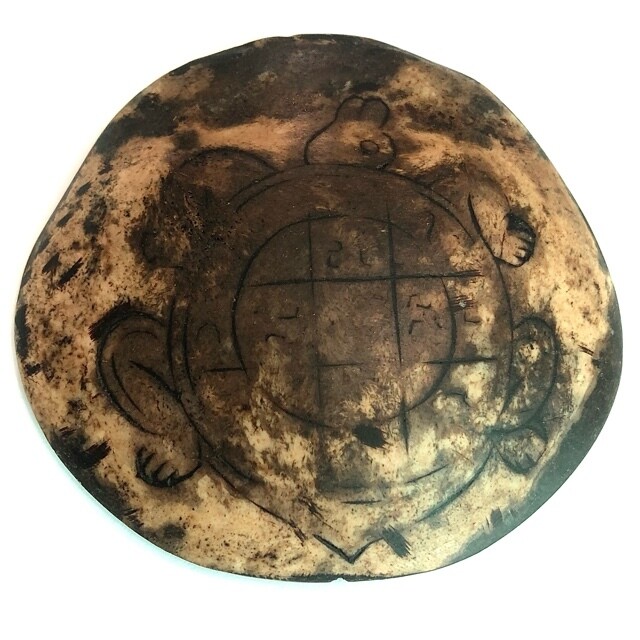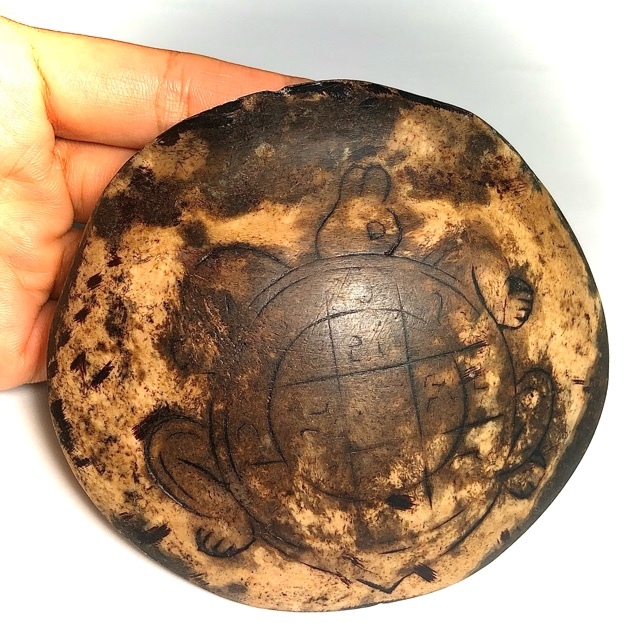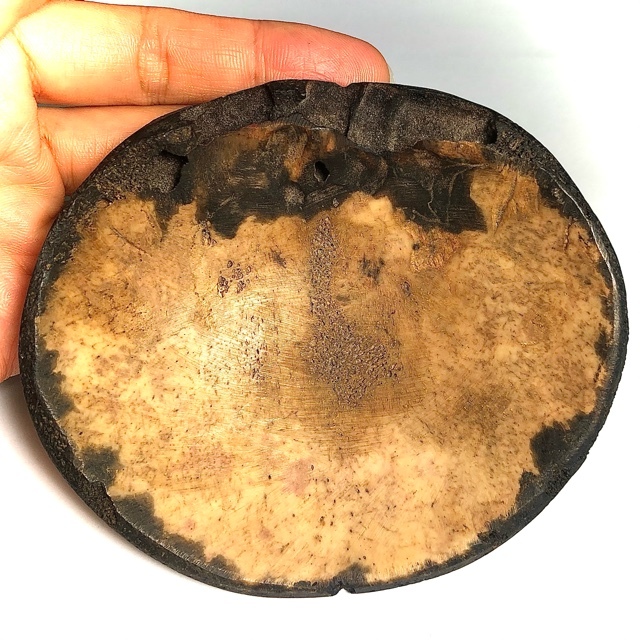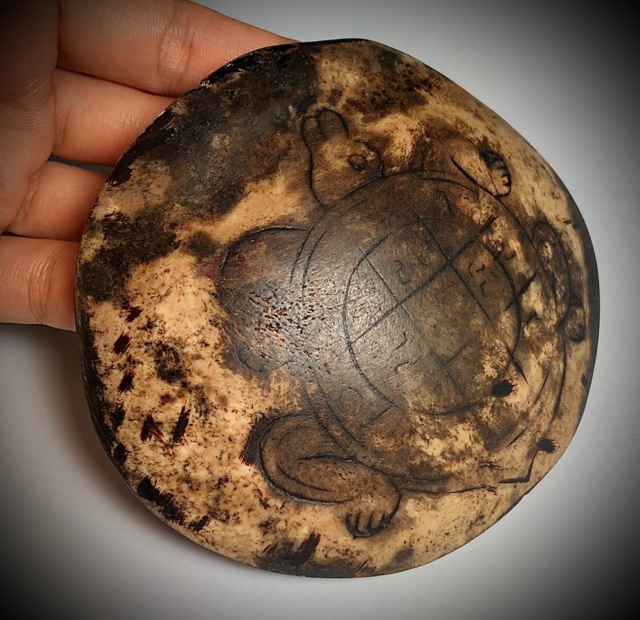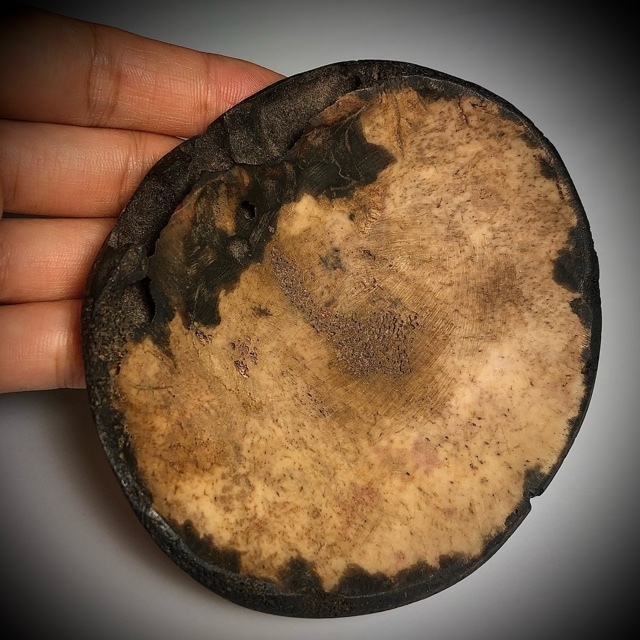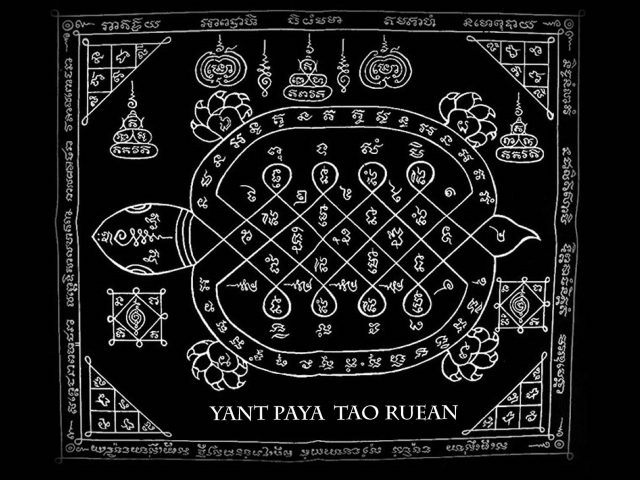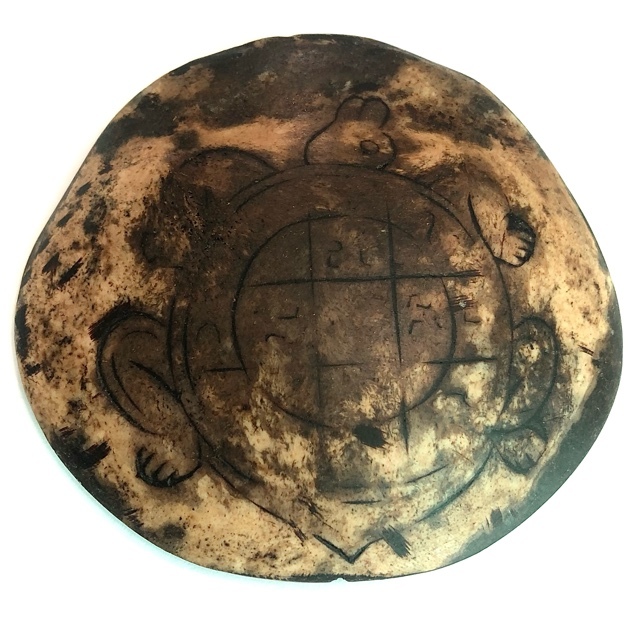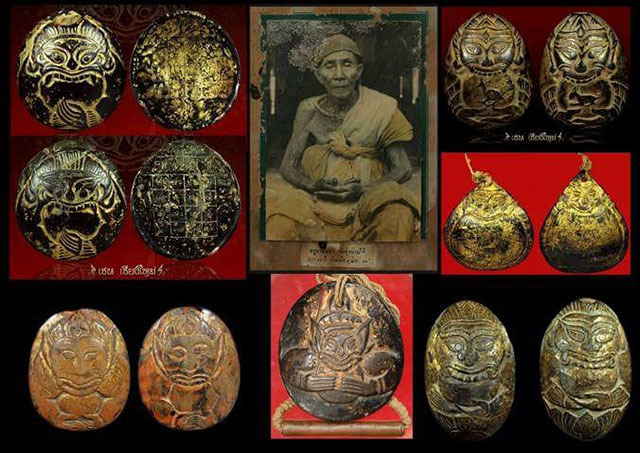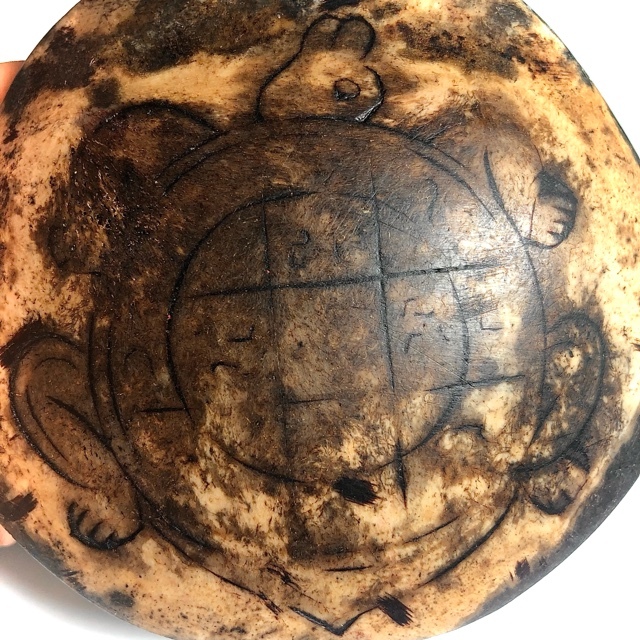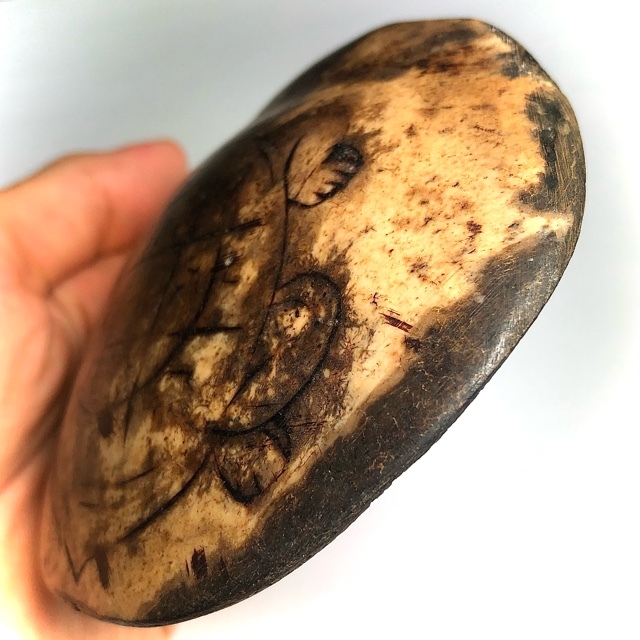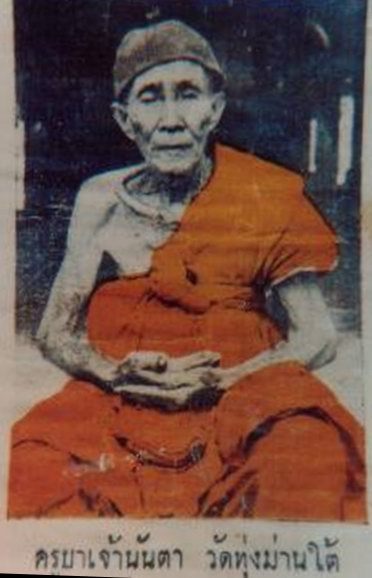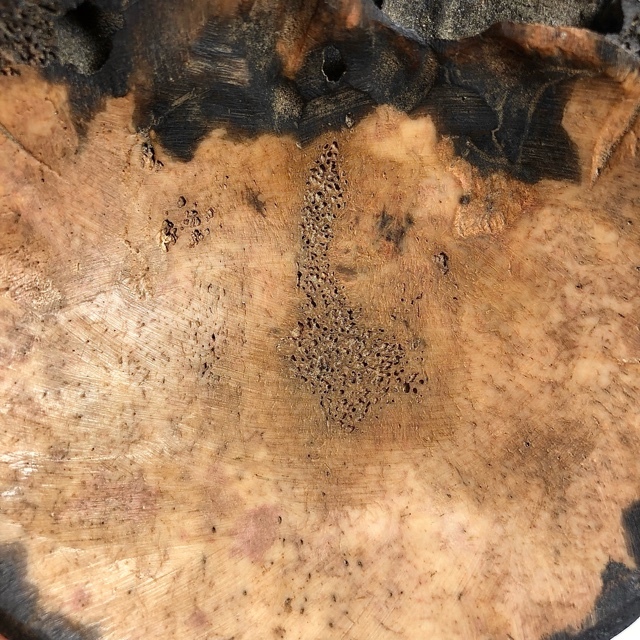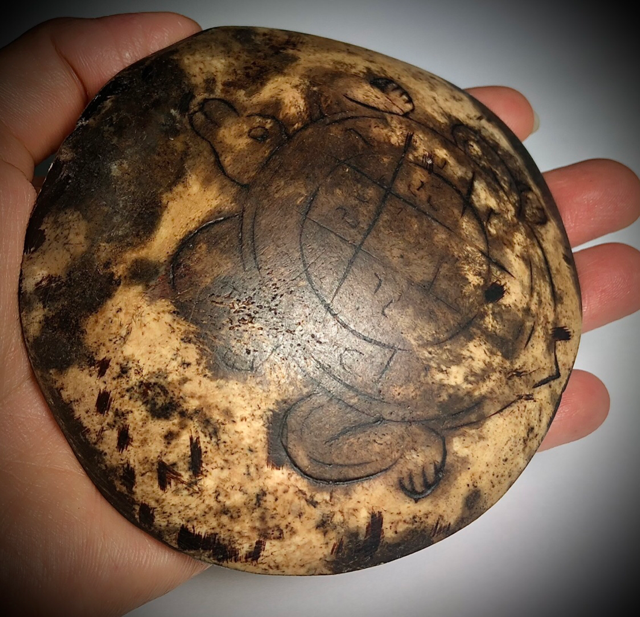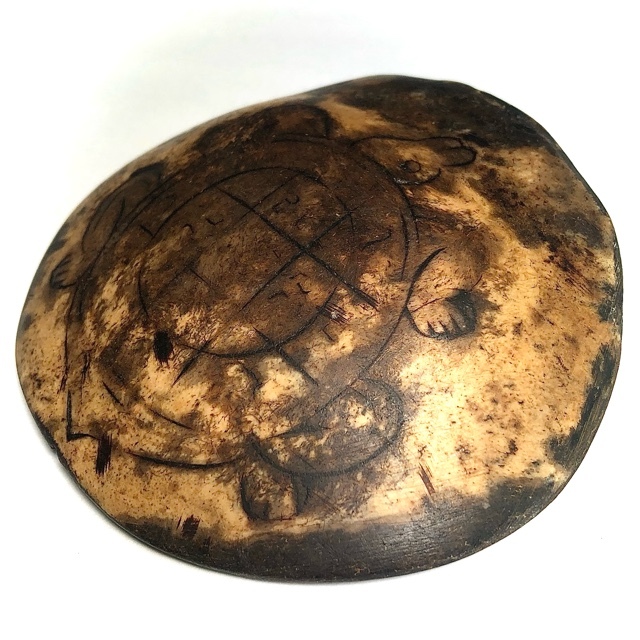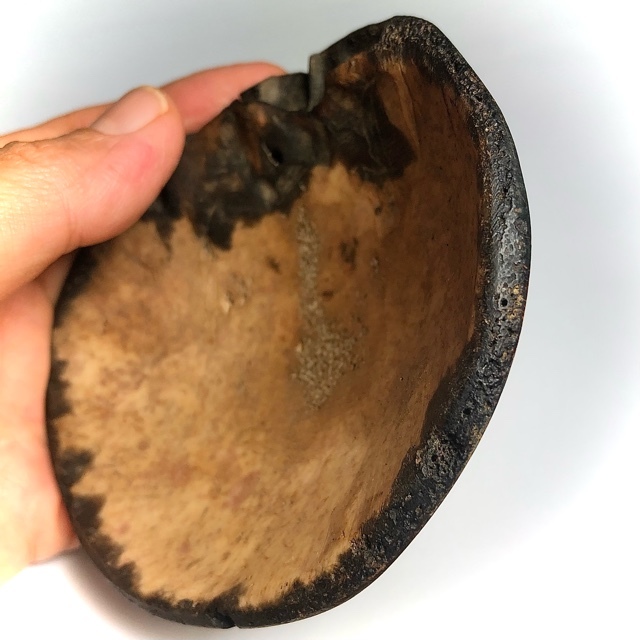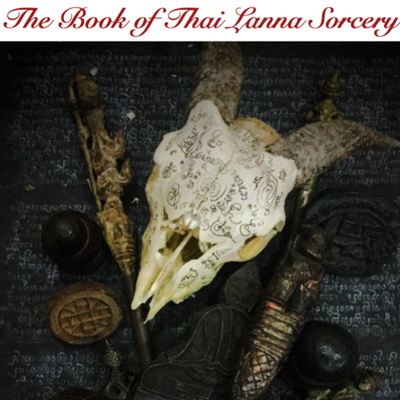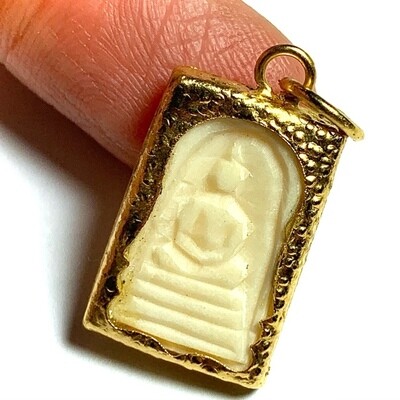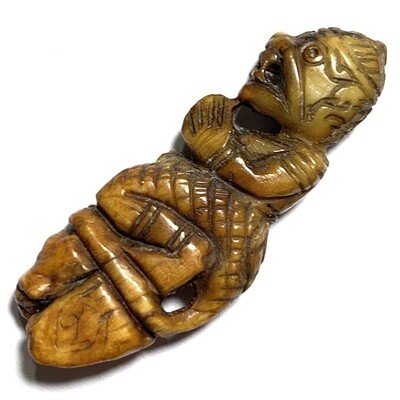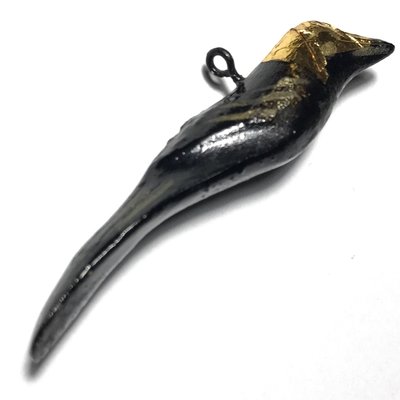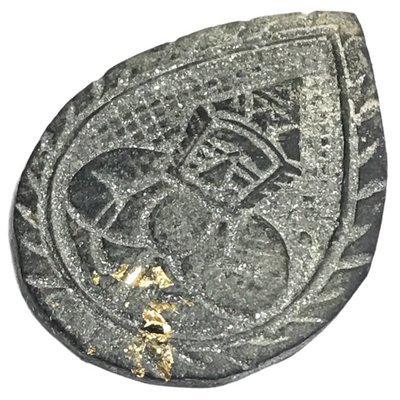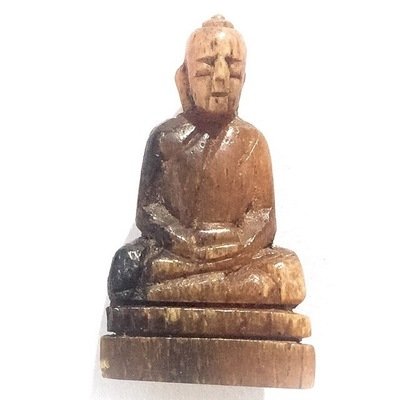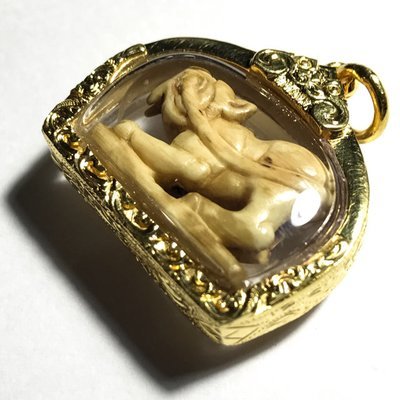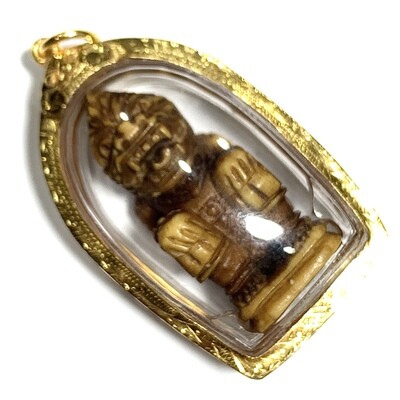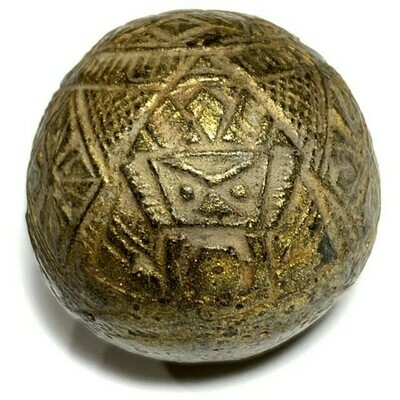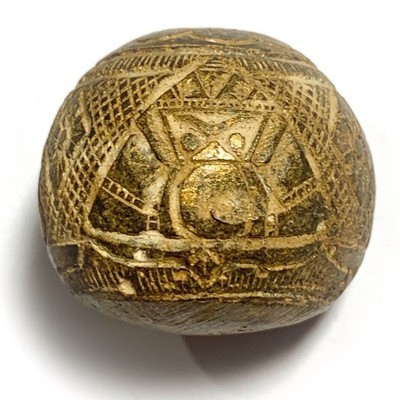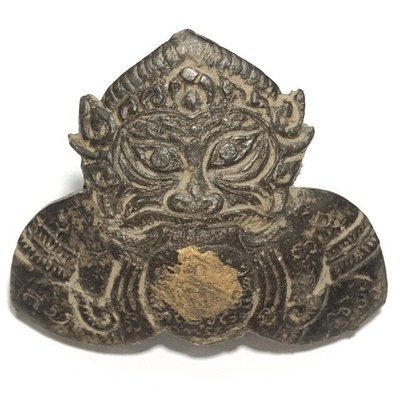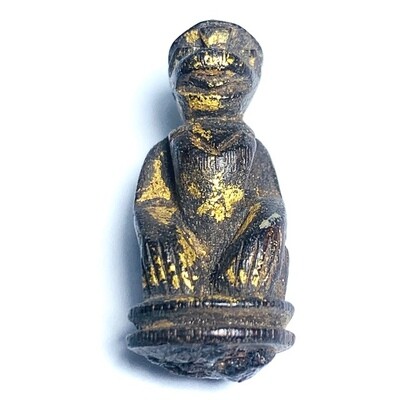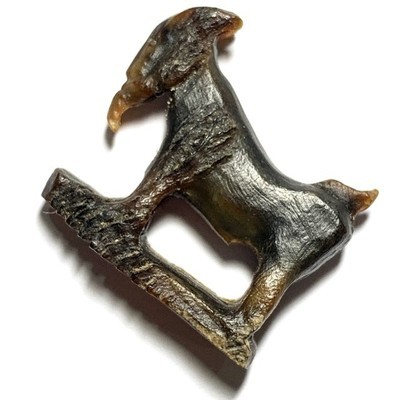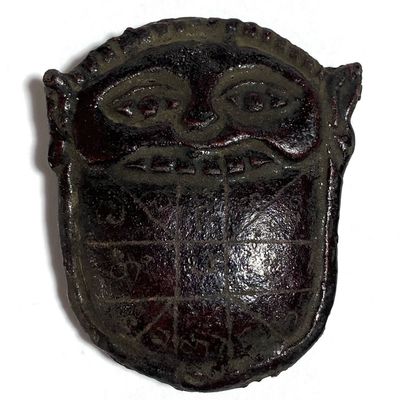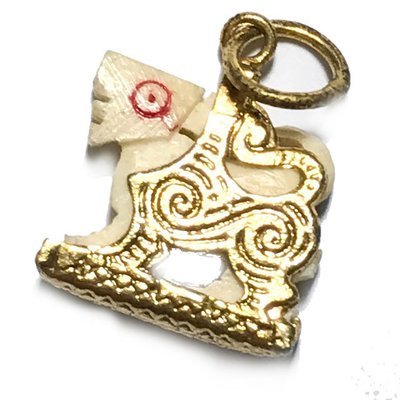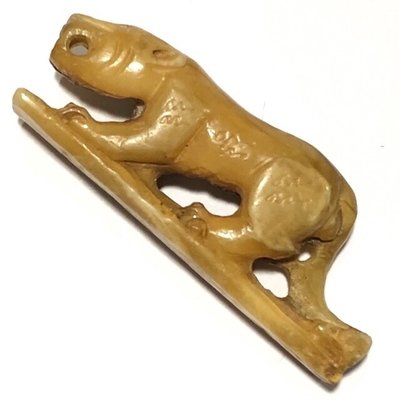One of the rarest and most highly revered and sought after Palad Khik of all Time, the Palad Khik Gae Nuea Mai Paya Ngiw Dam Dong Jarn Mer, of Luang Por Fak, of Wat Nikom Prachasan. Hand carved from sacred Deva inhabited black Ngiw treewood. The Palad Khik of Luang Por Fak is considered amongst the top five Palad Khik of all time, and carries Supreme Eminence in the Thai Collector Scene of the Krueang Rang Category, and for all Devotees of Palad Khik amulets.
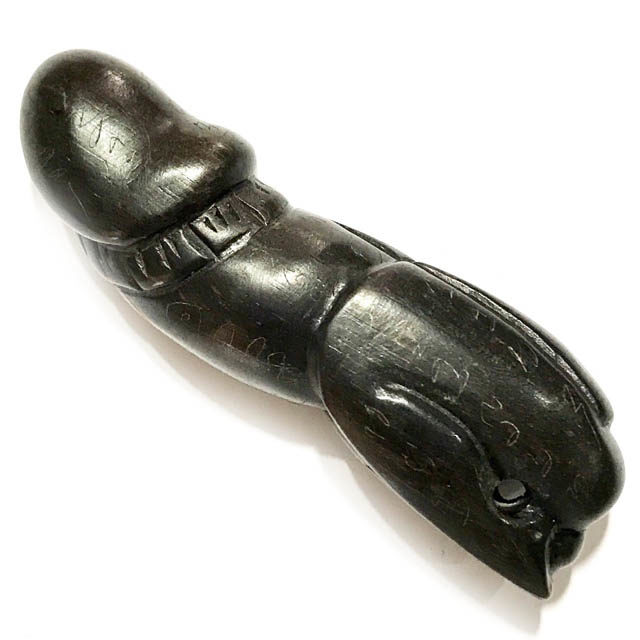
Palad Khik Mai Ngiw Dam Dong LP Fak with Hand Spell Inscriptions
Little is known of his Biography or Life before ordination, but it is known that he was the apprentice in Wicha to the great Luang Por Soke (also top 5 Palad Khik Master), and was the4 Kroo Ba Ajarn who taught the Wicha Palad Khik to the Great Luang Por Yid, of Wat Nong Jork. This Palad Khik from Luang Por Fak is in Pristine condition and exquisitely carved in the classic uniquitious curved shape which has come to be a trademark with the Palad Khik of Luang Por Fak.
A hole is drilled through the base of the Palad Khick for threading a cord through and attaching to a waistcord belt, or can alternatively be encased in waterproof casing with pendant hoop for wearing on a neckchain or belt as preferred.
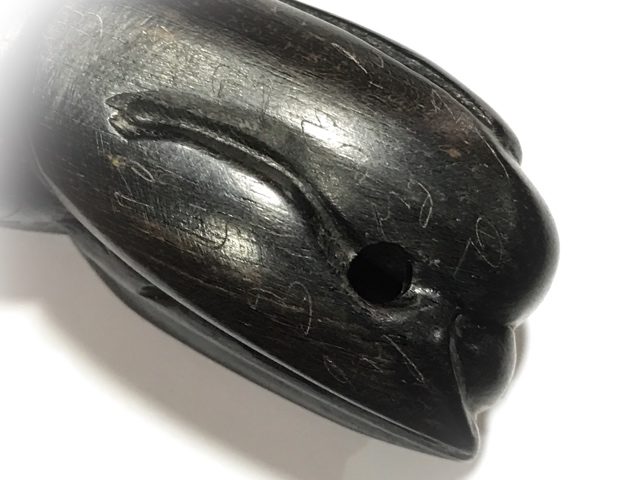
Hole drilled in base of Palad Khik Mai Ngiw Dam Dong LP Fak, for threading a cord for attachment to a belt or neckchain – Hand spell inscriptions can be seen on the surface of the sacred black Paya Ngiw Dam Dong Treewood.
The back of the Palad Khik has three holes where special Muan Sarn is inserted. The body of the the Palad Khik is formed in the clasic curved shape which has become known to be ubiquitous with the Palad Khik of this Master. This exhibit is extremely rare for the hand inscription of the Yant Dan Dta (Yant Dto) on the head of the Palad Khik, which is said to be found on only very rarely.
The Palad Khik of Luang Por Fak are highly renowned for Kong Grapan Chadtri (Invincibility), Klaew Klaad (Evasion of Deadly Accidents), Metta Maha Niyom n(Mercy Charm), Kaa Khaay (Selling Power), and Lai Phuudt Phii Pisaj (Chase Demons and Ghosts Away).
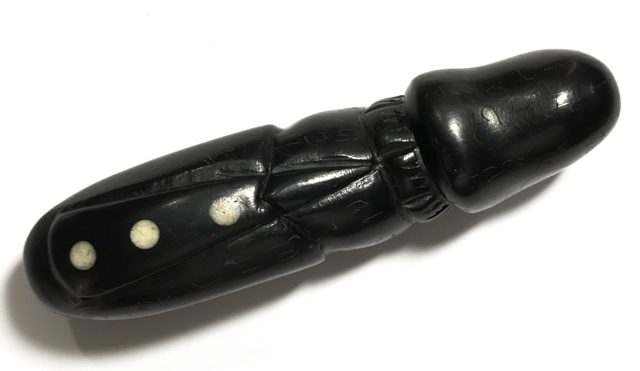
3 Muan Sarn Inserts in the Palad Khik Mai Ngiw Dam Dong LP Fak
The Palad Khik is empowered with the Kata; NA HI HA HU JA CHA DAN DTA
And the Kata Hua Jai Taw Waes Suwan “WAE SA PU SA”, and the Kata Hua Jai Ittijae for Metta Maha Sanaeh “I TA KA MA”, as well as the Kata Hua Jai Metta Karaniya Sutta “AE DTANG SA DTING”, topped off with the Hua Jai Maha Ud “UT TANG AD TO”.
11 Kinds of Blessings are included within the Magic of the Palad Khik’s Wicha; 1. Sleep peacefully, 2. Awaken with Happiness, 3. Protection against all Deadly Weaponry, 4. Immunity to Poisons, 5. Mercy Charm, 6. Good Business and Wealth Increase, 7. Convincing Speech, 8. Ward off Evil Spirits and Ghosts, 9. Improve Karma, 10. Protect Household and Property, 11. Increase Popularity & Chances of Promotion.
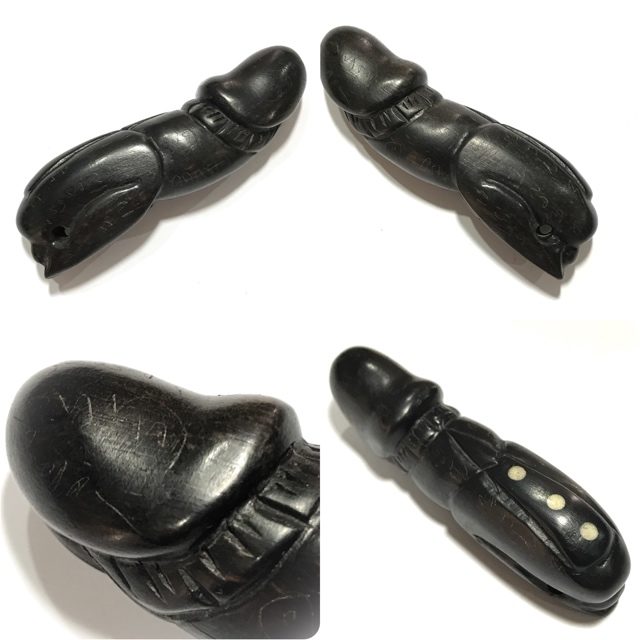
Palad Khik Mai Ngiw Dam Dong LP Fak
The Palad Khik is an Ancient Wicha, whose development can be traced right back to the Vedic Brahman Occult practices of Thousands of Years ago. Palad Khik amulets must be empowered by the repetition of incantations, which Thais call ‘Kata Bucha’, derived from the Devanagari ‘ghata poojah’. The incantations depend on the creator’s lineage in each school of traditional non-Buddhist animist magic.
Kata Bucha Palad Khik
Ganha Neha Na Ma Pa Ta
or
Ja Pa Ga Sa Na Mo Put Taa Ya Gan Ha Nae Ha Na Ma Pa Ta
or
Om Siwaling Sabbha Metta Sabbha Pokaa Sabbha Laapo Sabbha Tanaa, Sabbha Yasa, Sabbha Pranee Sabbha Mangalaani Bhavantume.
or
Om Laluay Mahaa Laluay Samsip Sorng Hee Hae Hom Lorm Dtorm Kuay Khor Hai Guu Ram Ruay Pro Hua Kuay An Nii Da Daa Di Dii Duu Dii Hee Maa Kuay Maa Burut Maa Dii Sadtrii Mii Maa Swaa Home
chant any one, or all of the Kata 3 times holding the Palad Khik before wearing
Ban Neng Wicha Lanna Long Rak Chart Carved Red Lacquered Skull Bone Necromantic Deva Spirit Amulet BE Kroo Ba Nanta
One of the rarest individual hand made ancient amulets of this Great Lanna Master, the Ban Neng Necromantic Skull Bone of a Hoeng Prai Ghost. with the Yant Paya Tao Ruean, Great Turtle Yantra. This exhibit from Lanna Thai Yai Hilltribe Master Monk Kroo Ba Nanta, is a very ancient Ban Neng Human Skull-Bone carving of a Khmer Hoeng Prai Ghost, exhumed from the grave many many years ago in ancient times. Being so ancient, this exhumed Ban Neng comes from a Hoeng Prai Ghost from Ancient times, when Magic was at its most believed in and powerfully present in the world.
This skull bone carving, is empowered with the Wicha Paya Tao Ruean, with an ancient and exquisitely carved Spell Inscriptions in Aghkara Lanna Magical Script. This carving is so visibly, recognizable as having the inscriptions of the Great Kroo Ba Nanta, diligently inscribed with the highest level of prowess. The exterior surface of the Ban Neng has been inscribed by hand with the image of the Paya Tao Ruean Yantra.
Free Express Shipping and the option of free solid silver Waterproof Casing is included with this item. An extremely rare, and exquisitely beautiful carving that is among the finest one could encounter by Olden days Lanna Master Guru Monk Kroo Ba Nanta Nanto Bhikku, of Wat Tung Man Dtai, in Lampang. Carvings of this level of fine detail, adherent to the ancient rules of the Dtamra of Lanna Necomantic Sorcery
This particular Ban Neng in fact, is beyond any kind of true price estimation (Hence 'Priceless'), for its beauty, spiritual and cultural value, & prowess of the inscriptions, with the immediately recognizably factors of an amulet of Kroo Ba Nanta, makes it a piece of fine art in itself, in a collector niche of 'The Man who has everything', that would not even blink to pay ten times what we would ask for this item. But we do not like the concept of traders offering different prices for the same item, depending on how wealthy the buyer is - we consider that fraudulent behavior, and unethical trader-attitude, same price for all with us. The price of an item such as this is not low in any case, so we see no reason why dishonest traders and those who sell to millionaires should 'bump up the price'. That is not necessary to succeed as an honest trustworthy trader. This is the philosophy of our curator Ajarn Spencer Littlewood.
Kroo Ba Nanta was the Kroo Ba Ajarn of Kroo Ba Lerd, of Wat Tung Man Dtai. Ban Neng Skullbone carvings are now truly a global rarity, and can mostly only be found as antiques from the Ancient Masters, although some years ago many lay masters began to revive the practice, which rose the attention of the government who noticed people beginning to become grave robbers to obtain skulls for making Ban Neng, and made a law to forbid the making of new age Ban Neng, and only accept antiques. Anyone now making them these days, if caught, is charged with criminal charges. It is hence very difficult to obtain this kind of powerful necromancy. The rear face reveals the pattern of the interior to be that of a human skull-bone.
Free Express shipping Worldwide is included with this amulet. The Ban Neng of Kroo Ba Nanta is a very rare thing to come by, and is known for extremely powerful magic for Maha Lap and Maha Pokasap, Wealth and Treasure accumulation, Gambling to convince the Ghost of the Gambling Dens to Gaze in your Favor, and for Maha Sanaeh Power of Attraction to Seduce. This kind of Ghost, and of course all Ban Neng Forehead Bone Carvings, are highly revered by Business Owners and those who are in sales, as well as those who seek to turn their fate around with lottery wins or lucky windfalls. Kroo Ba Nanta was one of the Greatest Lanna Masters in Living memory, before whose time, little is known of the names of the Masters who lived, so long ago was his Era.
Because of this, and his constant absence on forest Tudong wandering, it is not known when Kroo Ba Nanta began making Amulets, nor how many he made, except that old people who lived during his time, say that he had made them as long as they could remember. Many different shapes and forms of amulet can be found, but only the well trained eye can recognize his style of art, and when found, the inscriptions, and the natural ageing process of the coconut shell, ivory, bone, wood or sacred powders he used to make the amulets.
The earliest actual evidence of his making Ban Neng & Ban Nang Skull Bone, and famous Kala Ta Diaw one eyed coconut shell amulets, was found inscribed on a Kala ta Diaw Rahu Image from Kroo Ba Nanta with the year 2456 BE, which is considered to be one of his earlier one eyed coconut shell carvings.The amulet measures 5 x 4 Cm, and is made from one eyed albino coconut shell. Kroo Ba Nanta Nanto Bhikkhu was considered the older of the 2 Greatest Masters of the Wicha Pra Rahu of that particular Era, the other most famous Master being of course Luang Por Noi, of Wat Srisa Tong.
It would be more accurate to not compare the two, and to see that Kroo Ba Nanta and Luang Por Noi are equally Meritorious in their Mastery, and were perhaps the greatest Adepts of Wicha Pra Rahu in living memory. But although both Masters made Pra Rahu amulets, only Kroo Ba Nanta is known to have made Ban Neng skull bone carvings, but not Luang Por Noi.
The Paya Tao Ruean Turtle, is a very popular and sacred image in Thailand, which exists within local legends, and in Thai literature, magical occultism, sacred geometry, and Thai Buddhist Cosmogony. The Tao Ruean Turtle, is a very special Turtle, for it represents the Lord Buddha in one of his past lifetimes, as he was born as the Tao Ruean Turtle. It is recounted in the 'Ha Roi Chati' (500 Lives of Buddha) story. The Buddha was Incarnated as the Tao Ruean turtle, who lived on a desert island on top of a mountain, practicing purity and morality. The Tao Ruean Turtle, is one of a plethora of the Thai Buddhist Pantheon of Deities. The Tao Ruean turtle grew so large over the years, as to be as big as the size of a house. One day some sailors were shipwrecked on his island, and began to starve. They tried to eat the Areca nuts, which are of course inedible, and then when one of them died, they trussed the dead man up, and roasted him, to eat his flesh for survival. But this did not feed them for long, and they began to starve again. As time passed and they got desperate, and it began to seem as if they were going to begin killing each other, and become cannibals.
The Paya Tao Ruean turtle, looked down from the mountain, and was filled with mercy. He thought, 'I do not have anything to give these poor humans to eat, except for my own body. May i donate my large body, and its meat, for these humans to survive, and may i attain Nibbana one day for this deed'.
When the people got safely back to port and came home, they began to fashion turtles from clay or metal or carved from wood and place as an object of reverence in their homes, to pay respect and as a memorial of the Paya Tao Ruean who saved their lives, and to remind them to practice compassion, and to keep them protected from Danger, and bring them Long Life. The turtle then threw itself off the cliff, and fell bouncing down hitting the walls of the cliff, breaking its shell open, to land dead at the foot of the mountain on the beach in front of the sailors. The sailors then celebrated and paid respects to the great Paya Tao Ruean Turtle for his Mercy and Self Sacrifice, and survived until they were rescued by a passing ship.
The turtle is also a very meaningful Spiritual Symbol in many other Cultures of the World, such as the American Indian Belief system; Many Eastern North American aboriginal peoples tell how Sky Woman, Atanaesic, fell from heaven to land on the back of Turtle. The Buddha used a sea turtle to illustrate the precious rarity of opportunity afforded by our human birth. The turtle example appears in the scripture called in Pali, the Chiggala Sutta that is classified as LVI.48 of the Samyutta Nikaya. It is a metaphor known in English as The Hole:
"Monks, suppose that this great earth were totally covered with water, and a man were to toss a yoke with a single hole there. A wind from the east would push it west, a wind from the west would push it east. A wind from the north would push it south, a wind from the south would push it north. And suppose a blind turtle were there. It would come to the surface once every one hundred years. Now what do you think - Would that blind turtle, coming to the surface once every one hundred years, stick his neck into the yoke with a single hole?"
"It would be a sheer coincidence, Lord, that the blind turtle, coming to the surface once every one hundred years, would stick his neck into the yoke with a single hole."
"It is likewise a sheer coincidence that one obtains the human state. It is likewise a sheer coincidence that a Tathagata, worthy and rightly self-awakened, arises in the world. It is likewise a sheer coincidence that doctrine and discipline expounded by a Tathagata appears in the world.
"Now, this human state has been obtained, a Tathagata, worthy and rightly self-awakened, has arisen in the world. A doctrine and discipline expounded by a Tathagata appears in the world".
"Therefore your duty is the contemplation: `This is stress (Suffering). This is the origination of stress. This is the cessation of stress. This is the path of practice leading to the cessation of stress (Suffering)."
One of the best known Jatakas (Buddhist Fables of previous Incarnations of the Buddha Sakyamuni), is sometimes called The Turtle and the Geese. The story tells about a turtle who travels with a flock of geese, and does so by holding a wooden stick in his mouth, while two of the birds hold each end. When the turtle was unable to restrain himself from responding to a some young children who shouted out in surprise upon seeing the unusual sight, the turtle naturally fell to the ground and was killed.
The moral of the Jataka was of course: "Disaster can come from opening your mouth at the wrong time."
The Yant Paya Tao Ruean spell has so many different applications; you can inscribe it on a cake of face powder and use to powder your face with; People will feel pleased to see you, and you will be protected from people becoming unfriendly to you; even if your Boss at work is extremely angry with you, his anger will disappear immediately.
Use it to powder your face before entering a Court Case and our opponent will be silenced. Inscribe the name of the Person desired to be affected by the yant in the place where the letter “Pu” is (The centre square) write the person’s name first, then the letter Pu on top of it. If you wish to use this Yant to help you in an Exhibition/competition, inscribe the Yant on a sugar palm leaf along with the name of the targeted person.
Place the Yant under running water (such as a stream, fountain etc).Our opponent will be useless against us. Another application is as a love charm; Inscribe the Yant on a sugar palm leaf along with the name of targeted person. Use the leaf to roll a cigarette with, blow the smoke towards the person we wish to lure, and they will fall in love with us.
Give the rice to dogs to eat and chant the following:-Ta Hmaa Pood Dai; Hai Man Wa Kwam Chana Gae Rao - Ta Hmaa Pood Midai Ya Hai Man Wa Kwam Chana Rao Dai Ley The Kata means; “If the dog can speak - let him speak out against us and win - if the dog can’t speak - forbid him to speak out against us and win”.
Then take your foot and tap the dog’s mouth 3 times, whilst saying; “A” (3 times). If it is a very serious matter to be dealt with; inscribe the Yant on paper along with the name of the other person involved. Roll the Yant up and stuff it in the mouth of a “Pla Duk” (Catfish), take the hair of a corpse who died a violent death or drowning and use it to sew up the mouth of the catfish (use exactly three stitches to sew it up).
Chant the “A” Syllable three times whilst sewing.
Pierce the catfish with a skewer and roast it on a grill fire whilst chanting the following; Pla Nan Pen Yang Rai, Khor Hai Man Pen Yang Nan Terd.
Once the fish is roasted, give it to a dog to eat. You can give the dog one fish a day for three days and your problem will disappear. If your employer is angry with you; Inscribe the Yant on candle wrapping (thin paper) along with your employer’s name.
Soak it in perfumed oil and light the candle in the same manner as one does when praying to Buddha. The person targeted will be unable to be angry with us. If someone is making accusations (legal for example), take the yant on paper and a “Khong” seashell (a kind of clam). Close the lid of the clam again, and for Paya Dtao Luean/Ruean. Our accuser will be powerless to speak out against us.
Competition Winning Magic;
If you are competing in an exhibition or test or competition of some kind, inscribe Yant Paya Dtao Ruean on a sugar palm leaf. Inscribe the name of our competitor in the middle and the letter Pu in Khom on top of it. Place the Yant under running water (a brook, stream or waterfall for example). As the water flows offer the Leaf, our competitor will become weak and powerless. Can also be inscribed on a Banana leaf, rolled up into a cigarette using “Yaa Sen” (a thai tobacco alternative). Light the cigarette and blow the smoke towards the person we wish to charm; they will fall in love with us increasingly.
Please take heed, that if you use a love charm on somebody and it works, there is a very strict rule you have to follow; Namely, that if the spell works, you must never break up with him/her! For indeed, if you make them love you, they will be unable to live without you. Throwing that person away may lead to them killing themselves, or at least undergoing pain and sadness, more than the normal level that humans can usually withstand! So please be very considerate towards your newly gained lover if you use this kind of spell. abuse of a love spell on a person will bring you extremely Bad Karma.
If there is a matter to be solved inscribe Yant Paya Tao Ruean on candle paper (sai tien) and write the name of the other person/people involved, plus the name of the matter to be solved (write all over the Yant). Use the paper to wrap a candle with and light it:- Chant the kata until the candle goes out, take the ash residue from the candle and mix it together with some cooked rice (using your hand) - make 3 cakes out of it.
Miscellaneous
Water-divers like Otter, Beaver and Muskrat tried to bring up mud to form the earth. Traditions vary as to which one was successful. Sky Woman dies there, giving birth to her twins who embody the principles of Good and Evil.
The Astrological meanings within the Turtle Shell, and amulets, tattoos or cloth sacred geometry designs containing the Yant Paya Tao Ruean Spell, are also immensely powerful. It is well known, that the number of lunar months are embodied in the number of plates of a turtle shell: "13 moons on Turtle's back." Turtle amulets have of course the special magical quality of generating long life. All achievements will come steadily, if perhaps not rapidly but surely and secure growth will be certain.
Kroo Ba Nanta was born in 2415 BE, and was indeed the older of these two Great Guru masters of Wicha, both of whom were famous for the Pra Rahu, and also the Wua Tanu Sacred Arrow Bull, and many forms of Thai Lanna animist charms. Many people believe that Kroo Ba Nanta, was the Kroo Ba Ajarn of Luang Por Noi, but this is in fact a myth. Each of these Masters had their own personal Trajectories and their amulets differ in style and empowerment methods.
Kroo Ba Nanta was an Upachaya Monk (entitled to ordain people as monks, which is one of the highest statuses), and was responsible for having built many important Buddhist Edifices in Lampang, Chiang Rai, Payao, and surrounding provinces, including Uposatha Shrine Rooms for temples, Chedi Stupas (22 in all), Kuti Huts, and 26 Vihara Shrines.
It is said, that during the times of great difficulty of the Monk Kroo Ba Srivichai, as Kroo Ba Srivichai was placed under house arrest, that Kroo Ba Nanta made a Pra Rahu Kala Ta Diaw Amulet to pray to for the release of Kroo Ba Srivichai, and that he was released shortly after this. For this reason and for the experience of devotees, the Pra Rahu amulets of Kroo Ba Nanta are perhaps the most world famous of all his amulets.His Thai Lanna animist ghost charms are as little known, as the names and numbers of the numerous different Thai Ghosts found in folklore, number in the hundreds. He also blessed hand carved deities of other kinds as his famous Pra Rahu, and other Deities, but these are much much rarer, & harder to find in the pantheon of amulets of Kroo Ba Nanta.
To perform Bucha, use the following methods and incantations for the Hoeng Prai Spirit of the Skullbone;
When bringing the amulet into the home the first time, if you have other animist spirit charms such as Kumarn Tong or the like, please inform them of the new arrival of a new spirit as member of household, and, if possible with your home, light 16, 15, and 14 sticks of incense outside, before entering the building to call the angels of the 16 heavens, the spirits of the 15 dimensions of earth. and the deities of the 14 levels of the dimensions of the underworld, to give their blessings.
If you live in a condo or a place that is difficult to burn incense, you can either just use 5 sticks in the home (open the window if smoky), or use aromatic oil burner, as the numerology is not absolutely necessary. rather, it is necessary to make an effort to invite, welcome and make offerings of goodwill. What is in your heart is what matters more than the details of the ritual, but we document the full methods for those who both have the premises that allow it, and who enjoy performing the full form of ritual magick. However, one can keep it more simple if the heart is in the right place. After the first welcoming ritual, only one stick of incense only is needed when praying to the Hoeng Prai Ghost of the forehead bone, being a Prai Ghost. You can perform Rituals to the Paya Tapo Ruean Turtle in normal Fashion, and do not need to include the ghost in the announcement to the local spirits, because the Paya Tao Ruean dwells above and beyond Hoeng Prai Ghosts in the celestial realms, and is of much higher status and power, and need not ask permission from anybody to go where he wishes.
However, for most people who use Ban Neng, Necromantic Power is there to be used, and you can use the below Incantation for all kinds of Phuudtaa (Bhūta Ghosts) and Hun Payont type animist charms, to awaken the spirit of Hoeng Prai to assist when needed, chanting it either out loud, or silently within before approaching someone to use enchantment.
Call the spirit of a Ghost
Om Na Ma Pa Ta Jaedta Phuudto Maha Phuudtang Hun Payondtang Nimidtang Gang Ruubpang Bpiyang Ma Ma Aehi Aehi Na Mo Put Taa Ya
(chant 7 Times)
Bring it to Life and Command/Beseech it to assist.
So Sa A Ni So Sa A Ni Sa A Ni So A So A So Ni Ni Sa A So Ni So A So A Ni Yo Sa A A Ni So Sa Sa Ma Su
Alternative Kata
Sappa Bulo Su Sang A Wisang A A Gusalā Tammā Abpayā Kadtā Tammā - A Sang Wi Su Lo Bù Sa Pú Pá - Pá Pú Sa Bù Lo Su Wi Sang A Na Ma Pa Ta Hanumāna Wā Tō Nō A Ma Ma Waa Na Mo Put Tā Ya - Ja Pa Ga Sa
NA MA A U!!!! - U A MA!!!
Kata for giving food and offerings to Hoeng Prai Ghosts, Spirits and Devas
Yanginji Jidtang Itawaa Arungwaa Pochanangwaa Punchandti Aehi Na Ma Pa Ta Na La Poo Dtaa
Kata for Seducing others
Namo Poog Jidt Namo Poog Jai Namo Rak Krai Na Pag Jai Sangko Tanya Udti Sangkhodti
You can be flexible with what you offer, depending on what is convenient or what you feel your Deities will like to receive.
